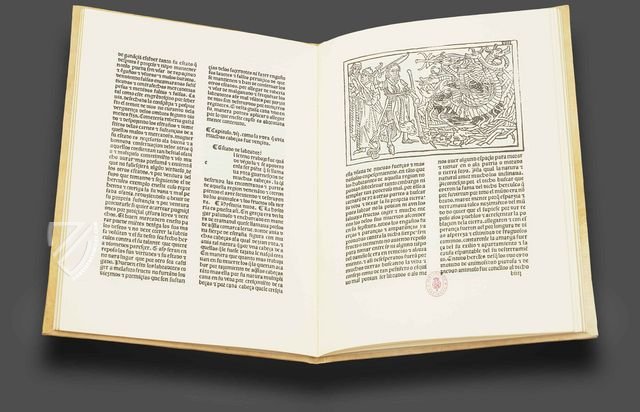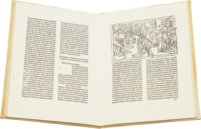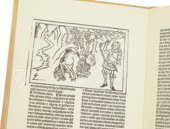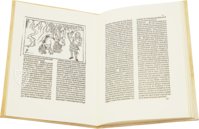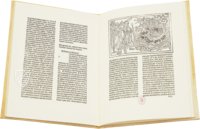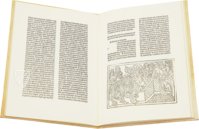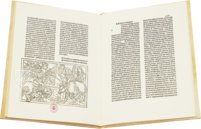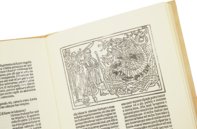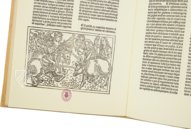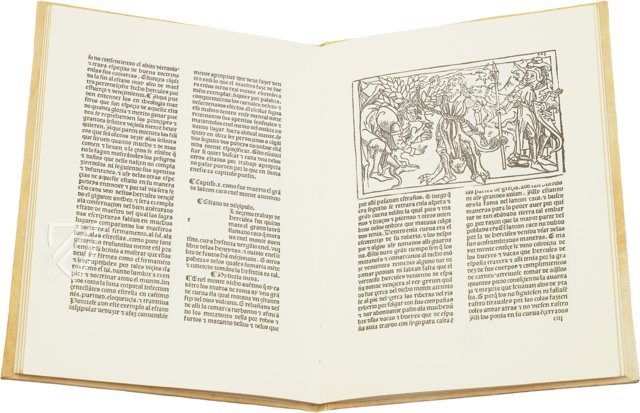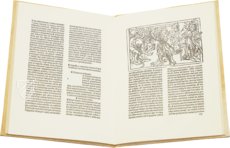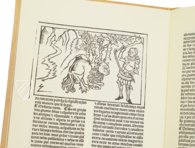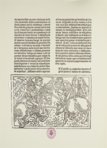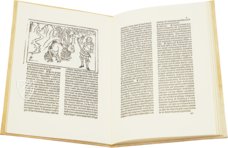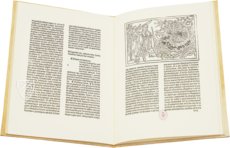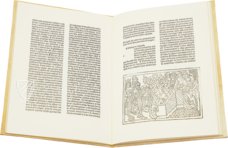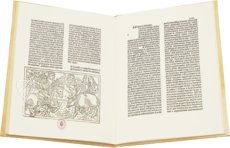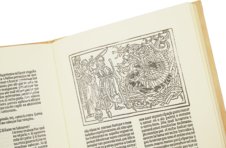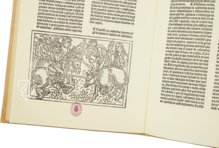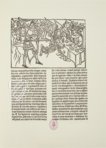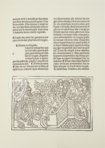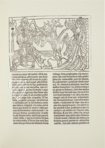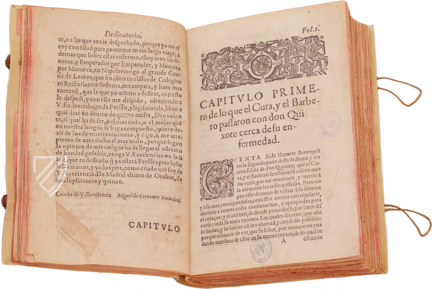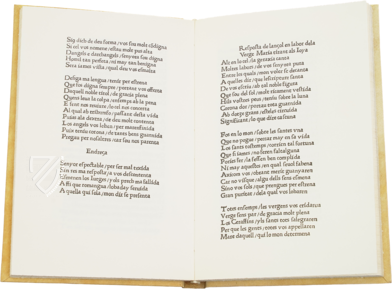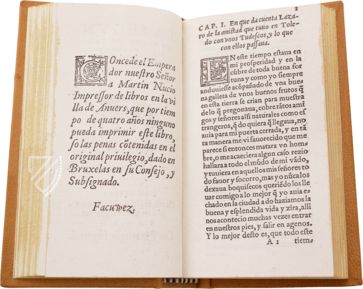The Twelve Labors of Hercules
(under 1,000€)
Born the son of Zeus and a mortal woman named Alcmene, Hercules was a Roman hero famous for his great strength and one of the most popular and well-known figures in Greek mythology – both in the Middle Ages and today. As was common for ancient pagan myths as well as other texts, the tale was reinterpreted as a Christian allegory by medieval authors. One of these authors was Marqués Enrique de Villena (1384–1434), a Spanish nobleman, writer, poet and theologian. He wrote a Catalan version of the ancient heroic myth in 1417, which was intended to inspire his readers to to a lead an honorable life, and which he later translated into Castilian. Based on this translation, the first edition appeared on January 15, 1483, printed by Antón de Centenera (c. 1450–1504) in Zamora. The Spanish incunabulum originally featured twelve large woodcuts, eleven of which have survived, each illustrating one of the twelve labors of Hercules. A wonderful testimony to the early Spanish art of printing!
The Twelve Works of Hercules
Don Enrique de Villena (1384–1434), Marquess of Villena, was a Spanish author, poet, and theologian who also was reputed to be a necromancer. Although belonging to the former royal house of Aragon, his political ambitions were denied him, and so he committed himself as an author. He is most famous for his Los Trabajos de Hércules, the first edition of which was published in Zamora on January 15, 1483. However, he created the first version of the work much earlier in 1417 shortly before his departure from the Aragonese court. He initially wrote in Catalan, but only a few months later made a Castilian translation himself, on the basis of which the printing was truly masterfully executed by Antón de Centenera. The latter was one of the earliest known printers on the Iberian Peninsula and is known for his characterful works. With Los Trabajos de Hércules he created an exemplary Spanish incunabulum, i.e. a book printed before 1501.
An ancient hero as a Christian ideal
Villena's text is a synthesis of Greek mythology and Christian allegory full of moralizing messages intended to encourage particularly nobles and clerics to virtuous behavior. The book is divided into 12 chapters - one for each labor of Hercules - , each of which is then divided into four parts. The first section in each case contains a rendering of the legend, which is followed by an allegorical interpretation, a review of the truth content, and a section on the moral utility of the tale. While the individual chapter headings are barely noticeable in the neat two-column typesetting, there is an almost half-page woodcut at the beginning of each of the twelve chapters as a visual marker and aide memoire. The magnificent xylographs are by a Spanish artist, though only 11 of the 12 original images survive: the depiction of the Battle against the Centaur, actually a secondary labor, has been lost. Nevertheless, the incunabulum remains a wonderful testimony to early Spanish book printing.
Codicology
- Alternative Titles
- Die zwölf Aufgaben des Herkules
Die zwölf Taten des Herakles
Die zwölf Arbeiten des Herakles
Los (Doce) Trabajos de Hercules
The Twelve Works of Hercules - Size / Format
- 68 pages / 27.5 × 20.5 cm
- Origin
- Spain
- Date
- January 15, 1483
- Epochs
- Style
- Language
- Script
- Gothic
- Illustrations
- 11 large woodcuts
- Content
- Medieval version of the legend of Hercules
- Artist / School
- Enrique de Villena (author)
Antón de Centenera (printer)
The Twelve Labors of Hercules
Cerberus
The capture of Cerberus, the three-headed, dragon-tailed dog that guarded the gates of the Underworld, was the twelfth and final labor of Hercules. Hades, lord of the Underworld, only agreed to let Hercules take Cerberus to the surface if he could do it without weapons. This woodcut shows Hercules holding a chain, which is secured around one of the necks of the beast. Persephone, Hade’s queen and a sibling of Hercules, stands at the gates wearing flowing robes and looking thoroughly displeased.
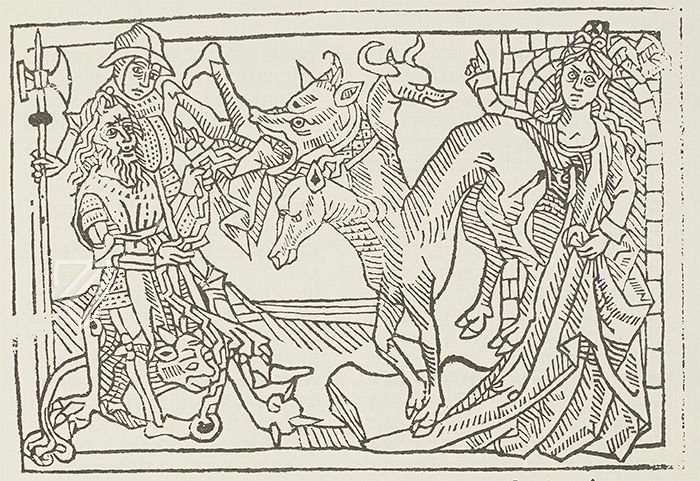
The Twelve Labors of Hercules
Golden Apples of the Hesperides
After Hercules completed the first ten labors, Eurystheus gave him two more, claiming that neither slaying the Hydra nor cleaning the Augean Stables counted because he had cheated. He was thus sent to steal three of the golden apples from the garden of the Hesperides. After learning of its location from the Old Man of the Sea, the shapeshifting sea god, he went to the garden where he slew Ladon, the dragon who guarded the apples.
The woodcut appears at the bottom of a page with a conspicuously blank area where a decorative initial ought to be. Many early printed books did this so that the purchaser could have initials hand painted according to their personal tastes. Similarly, the woodcuts could also be colored by an artist at a later time.
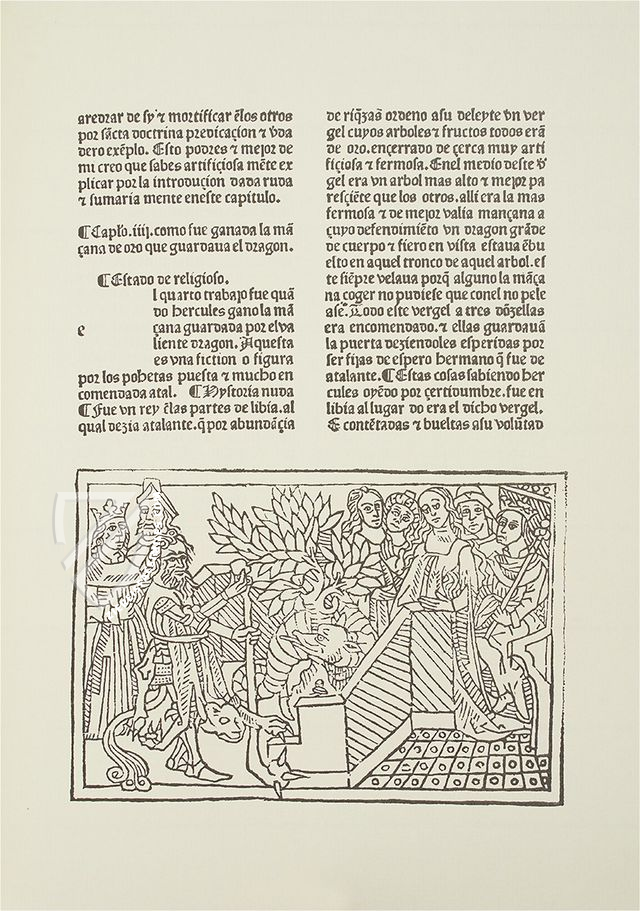
#1 Los (Doce) Trabajos de Hercules
Language: Spanish
(under 1,000€)
- Treatises / Secular Books
- Apocalypses / Beatus
- Astronomy / Astrology
- Bestiaries
- Bibles / Gospels
- Chronicles / History / Law
- Geography / Maps
- Saints' Lives
- Islam / Oriental
- Judaism / Hebrew
- Single Leaf Collections
- Leonardo da Vinci
- Literature / Poetry
- Liturgical Manuscripts
- Medicine / Botany / Alchemy
- Music
- Mythology / Prophecies
- Psalters
- Other Religious Books
- Games / Hunting
- Private Devotion Books
- Other Genres
- Afghanistan
- Armenia
- Austria
- Belgium
- Belize
- Bosnia and Herzegovina
- China
- Colombia
- Costa Rica
- Croatia
- Cyprus
- Czech Republic
- Denmark
- Egypt
- El Salvador
- Ethiopia
- France
- Germany
- Greece
- Guatemala
- Honduras
- Hungary
- India
- Iran
- Iraq
- Israel
- Italy
- Japan
- Jordan
- Kazakhstan
- Kyrgyzstan
- Lebanon
- Liechtenstein
- Luxembourg
- Mexico
- Morocco
- Netherlands
- Palestine
- Panama
- Peru
- Poland
- Portugal
- Romania
- Russia
- Serbia
- Spain
- Sri Lanka
- Sweden
- Switzerland
- Syria
- Tajikistan
- Turkey
- Turkmenistan
- Ukraine
- United Kingdom
- United States
- Uzbekistan
- Vatican City
- A. Oosthoek, van Holkema & Warendorf
- Aboca Museum
- Ajuntament de Valencia
- Akademie Verlag
- Akademische Druck- u. Verlagsanstalt (ADEVA)
- Aldo Ausilio Editore - Bottega d’Erasmo
- Alecto Historical Editions
- Alkuin Verlag
- Almqvist & Wiksell
- Amilcare Pizzi
- Andreas & Andreas Verlagsbuchhandlung
- Archa 90
- Archiv Verlag
- Archivi Edizioni
- Arnold Verlag
- ARS
- Ars Magna
- ArtCodex
- AyN Ediciones
- Azimuth Editions
- Badenia Verlag
- Bärenreiter-Verlag
- Belser Verlag
- Belser Verlag / WK Wertkontor
- Benziger Verlag
- Bernardinum Wydawnictwo
- BiblioGemma
- Biblioteca Apostolica Vaticana (Vaticanstadt, Vaticanstadt)
- Bibliotheca Palatina Faksimile Verlag
- Bibliotheca Rara
- Boydell & Brewer
- Bramante Edizioni
- Bredius Genootschap
- Brepols Publishers
- British Library
- C. Weckesser
- Caixa Catalunya
- Canesi
- CAPSA, Ars Scriptoria
- Caratzas Brothers, Publishers
- Carus Verlag
- Casamassima Libri
- Centrum Cartographie Verlag GmbH
- Chavane Verlag
- Christian Brandstätter Verlag
- Circulo Cientifico
- Club Bibliófilo Versol
- Club du Livre
- CM Editores
- Collegium Graphicum
- Collezione Apocrifa Da Vinci
- Comissão Nacional para as Comemorações dos Descobrimentos Portugueses
- Coron Verlag
- Corvina
- CTHS
- D. S. Brewer
- Damon
- De Agostini/UTET
- De Nederlandsche Boekhandel
- De Schutter
- Deuschle & Stemmle
- Deutscher Verlag für Kunstwissenschaft
- DIAMM
- Droz
- E. Schreiber Graphische Kunstanstalten
- Ediciones Boreal
- Ediciones Grial
- Ediclube
- Edições Inapa
- Edilan
- Editalia
- Edition Deuschle
- Edition Georg Popp
- Edition Leipzig
- Edition Libri Illustri
- Editiones Reales Sitios S. L.
- Éditions de l'Oiseau Lyre
- Editions Medicina Rara
- Editorial Casariego
- Editorial Mintzoa
- Editrice Antenore
- Editrice Velar
- Edizioni Edison
- Egeria, S.L.
- Eikon Editores
- Electa
- Emery Walker Limited
- Enciclopèdia Catalana
- Eos-Verlag
- Ephesus Publishing
- Ernst Battenberg
- Eugrammia Press
- Extraordinary Editions
- Fackelverlag
- Facsimila Art & Edition
- Facsimile Editions Ltd.
- Facsimilia Art & Edition Ebert KG
- Faksimile Verlag
- Feuermann Verlag
- Folger Shakespeare Library
- Franco Cosimo Panini Editore
- Friedrich Wittig Verlag
- Fundación Hullera Vasco-Leonesa
- G. Braziller
- Gabriele Mazzotta Editore
- Gebr. Mann Verlag
- Gesellschaft für graphische Industrie
- Getty Research Institute
- Giovanni Domenico de Rossi
- Giunti Editore
- Graffiti
- Grafica European Center of Fine Arts
- Guido Pressler
- Guillermo Blazquez
- Gustav Kiepenheuer
- H. N. Abrams
- Harrassowitz
- Harvard University Press
- Helikon
- Hendrickson Publishers
- Henning Oppermann
- Herder Verlag
- Hes & De Graaf Publishers
- Hoepli
- Holbein-Verlag
- Houghton Library
- Hugo Schmidt Verlag
- Idion Verlag
- Il Bulino, edizioni d'arte
- ILte
- Imago
- Insel Verlag
- Insel-Verlag Anton Kippenberger
- Instituto de Estudios Altoaragoneses
- Instituto Nacional de Antropología e Historia
- Introligatornia Budnik Jerzy
- Istituto dell'Enciclopedia Italiana - Treccani
- Istituto Ellenico di Studi Bizantini e Postbizantini
- Istituto Geografico De Agostini
- Istituto Poligrafico e Zecca dello Stato
- Italarte Art Establishments
- Jan Thorbecke Verlag
- Johnson Reprint Corporation
- Josef Stocker
- Josef Stocker-Schmid
- Jugoslavija
- Karl W. Hiersemann
- Kasper Straube
- Kaydeda Ediciones
- Kindler Verlag / Coron Verlag
- Kodansha International Ltd.
- Konrad Kölbl Verlag
- Kurt Wolff Verlag
- La Liberia dello Stato
- La Linea Editrice
- La Meta Editore
- Lambert Schneider
- Landeskreditbank Baden-Württemberg
- Leo S. Olschki
- Les Incunables
- Liber Artis
- Library of Congress
- Libreria Musicale Italiana
- Lichtdruck
- Lito Immagine Editore
- Lumen Artis
- Lund Humphries
- M. Moleiro Editor
- Maison des Sciences de l'homme et de la société de Poitiers
- Manuscriptum
- Martinus Nijhoff
- Maruzen-Yushodo Co. Ltd.
- MASA
- Massada Publishers
- McGraw-Hill
- Metropolitan Museum of Art
- Militos
- Millennium Liber
- Müller & Schindler
- Nahar - Stavit
- Nahar and Steimatzky
- National Library of Wales
- Neri Pozza
- Nova Charta
- Oceanum Verlag
- Odeon
- Orbis Mediaevalis
- Orbis Pictus
- Österreichische Staatsdruckerei
- Oxford University Press
- Pageant Books
- Parzellers Buchverlag
- Patrimonio Ediciones
- Pattloch Verlag
- PIAF
- Pieper Verlag
- Plon-Nourrit et cie
- Poligrafiche Bolis
- Presses Universitaires de Strasbourg
- Prestel Verlag
- Princeton University Press
- Prisma Verlag
- Priuli & Verlucca, editori
- Pro Sport Verlag
- Propyläen Verlag
- Pytheas Books
- Quaternio Verlag Luzern
- Reales Sitios
- Recht-Verlag
- Reichert Verlag
- Reichsdruckerei
- Reprint Verlag
- Riehn & Reusch
- Roberto Vattori Editore
- Rosenkilde and Bagger
- Roxburghe Club
- Salerno Editrice
- Saltellus Press
- Sandoz
- Sarajevo Svjetlost
- Schöck ArtPrint Kft.
- Schulsinger Brothers
- Scolar Press
- Scrinium
- Scripta Maneant
- Scriptorium
- Shazar
- Siloé, arte y bibliofilia
- SISMEL - Edizioni del Galluzzo
- Sociedad Mexicana de Antropología
- Société des Bibliophiles & Iconophiles de Belgique
- Soncin Publishing
- Sorli Ediciones
- Stainer and Bell
- Studer
- Styria Verlag
- Sumptibus Pragopress
- Szegedi Tudomànyegyetem
- Taberna Libraria
- Tarshish Books
- Taschen
- Tempus Libri
- Testimonio Compañía Editorial
- Thames and Hudson
- The Clear Vue Publishing Partnership Limited
- The Facsimile Codex
- The Folio Society
- The Marquess of Normanby
- The Richard III and Yorkist History Trust
- Tip.Le.Co
- TouchArt
- TREC Publishing House
- TRI Publishing Co.
- Trident Editore
- Tuliba Collection
- Typis Regiae Officinae Polygraphicae
- Union Verlag Berlin
- Universidad de Granada
- University of California Press
- University of Chicago Press
- Urs Graf
- Vallecchi
- Van Wijnen
- VCH, Acta Humaniora
- VDI Verlag
- VEB Deutscher Verlag für Musik
- Verlag Anton Pustet / Andreas Verlag
- Verlag Bibliophile Drucke Josef Stocker
- Verlag der Münchner Drucke
- Verlag für Regionalgeschichte
- Verlag Styria
- Vicent Garcia Editores
- W. Turnowski Ltd.
- W. Turnowsky
- Waanders Printers
- Wiener Mechitharisten-Congregation (Wien, Österreich)
- Wissenschaftliche Buchgesellschaft
- Wissenschaftliche Verlagsgesellschaft
- Wydawnictwo Dolnoslaskie
- Xuntanza Editorial
- Zakład Narodowy
- Zollikofer AG

